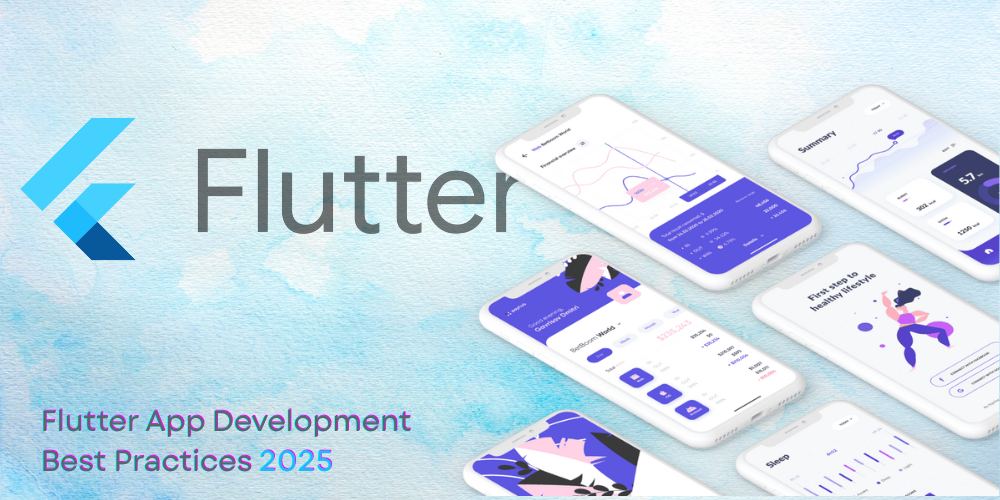Flutter App Development: Best Practices 2025

Introduction
Creating high-performing, scalable, and user-friendly mobile applications is the goal of every developer. With Flutter gaining popularity as the go-to framework for cross-platform app development, it’s vital to follow best practices to ensure your app runs smoothly in 2025 and beyond. This blog will walk you through the latest Flutter app development best practices, organized in a simple and effective Google-style guide format.
1. Write Clean and Maintainable Code
Why it matters: Clean code is easy to read, debug, and scale. As your application grows, having a maintainable codebase becomes critical.
Best Practices:
- Use meaningful naming conventions.
- Avoid nested builders.
- Follow the SOLID principles.
- Organize your code using the feature-first folder structure.
- Create reusable widgets to avoid redundancy.
2. Optimize Widget Trees
Why it matters: Unoptimized widget trees can lead to unnecessary rebuilds and performance lags.
Best Practices:
- Use
constconstructors wherever possible. - Leverage
ListView.builderinstead ofListViewfor dynamic lists. - Break down complex UIs into smaller widgets.
- Use the
ProviderorRiverpodpackage for effective state management.
Pro Tip: Avoid rebuilding the entire widget tree when only part of the UI changes.
3. Use Effective State Management
Why it matters: Proper state management ensures your app is responsive and easier to debug.
Best Practices:
- For small projects, use
ProviderorsetState(). - For medium to large apps, consider
Riverpod, Bloc, orGetX. - Separate business logic from UI to follow the MVVM pattern.
- For small projects, use
4. Focus on Performance Optimization
Why it matters: No user enjoys a slow app. Flutter provides tools to measure and improve performance.
Best Practices:
- Minimize widget rebuilds using
constandshouldRebuild()methods. - Use
RepaintBoundarywhere necessary. - Optimize image loading with
cached_network_image. - Use
Flutter DevToolsto identify performance bottlenecks.
5. Use Responsive and Adaptive Design
Why it matters: Users access your app from different screen sizes and orientations.
Best Practices:
- Use
MediaQueryandLayoutBuilderto make the UI responsive. - Implement adaptive widgets for different platforms (Android/iOS/Web).
- Test your app across multiple devices and screen sizes.
6. Write Comprehensive Tests
Why it matters: Testing ensures your code is reliable and minimizes bugs in production.
Best Practices:
- Write unit tests for business logic.
- Use widget tests for UI.
- Perform integration testing using
flutter_testandintegration_testpackages. - Automate testing with CI/CD tools like GitHub Actions or Bitrise.
7. Leverage Modern Flutter Features
Why it matters: Flutter is constantly evolving. Using new features keeps your app modern and efficient.
Best Practices:
- Use
Material 3components. - Explore
Flutter WebAssembly(when stable) for faster web performance. - Use
null safetyto prevent runtime errors. - Integrate Firebase or Supabase for modern backend solutions.
Frequently Asked Questions (FAQ)
Q1: What is the best state management solution in 2025 for Flutter?
A: Riverpod and Bloc are leading choices for scalable, testable state management.
Q2: How can I make my Flutter app faster?
A: Optimize widget rebuilds, lazy load images, use DevTools, and avoid unnecessary computations.
Q3: Should I use Flutter for large-scale enterprise apps?
A: Absolutely. With the right architecture, Flutter scales very well for enterprise-level apps.
Q4: Is Flutter still relevant in 2025?
A: Yes, with constant updates and growing community support, Flutter remains one of the best frameworks for cross-platform development.
Conclusion
Flutter continues to be a top contender for cross-platform app development in 2025. By adopting these best practices, you can ensure that your app is not just functional but also robust, efficient, and user-friendly. Remember to keep your code clean, structure your widget tree wisely, use modern state management, and always test your app thoroughly.




